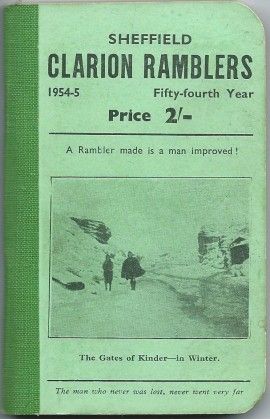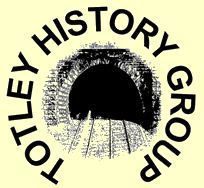Sheffield Clarion Ramblers Booklet, 54th Year, 1954-55

Totley and Gillfield (pages 62-64)
Totley, beside the Baslow road (since 1919) is almost smothered by Sheffield's suburbia; if it be the beginning of local rambles which Mancunians would envy. On the slopes, rising towards Owler Bar, its name derived from "Totinglei" in "Doomsday Book" of 1087, may well mean the lookout place on the high bank and top fields - on the left (E.) side of Baslow road, beyond the Cross Scythes Inn. There are "Tot" and "Toot" names elsewhere, but where's the proof, or of a British open-air worship-place or hill-fort.
Gillfield Wood was felled in 1943, (not yet replanted) and, possibly, it was a long three-quarter mile of natural wood. Every Sheffield rambler knows it. There are Gills and Greens in Totley to-day. A "Leonard Gill, gentleman", possessed a lead-mill or smelting house, at Totley, probably by, or at, the later and now known "Chemical Yard," (behind the red brick house and shops, row), by the Totley Brook - to which lead was taken and paint was made in the early 19th century, and before.
This Leonard Gill probably lived at Norton House, Norton, demolished in 1880, and wherein, on the best room mantel-piece, our old master-antiquarian, the late S. O. Addy, saw the letters "Le G" inscribed. Gill also had a "shot", or bullet factory, at Greenhill - another Sheffield-smothered village - since 1900. He married in 1607, and, in 1626, he was "suspected" by the Privy Council. Leonard's eldest son, Edward, married a daughter of Stephen Bright, Carbrook, Sheffield. In a document of 3/3/1630, this rich Bright and Thomas Sharpe, of London, gave the Earl of Pembroke, Sir B. Rudyard and Sir R. Pye, £1,850 for all their estate in Totley manor, in which there were six farms, a corn mill, Leonard Gill's previously bought smelting house, and some waste, or common lands.
Until something better comes along, my guess is that Gillfield Wood comes from the Gill family who, in Totley, can still debate about their ancestry, but, unlike "Yankeeised" Britishers, refuse to feed solicitors with search-money for pedigrees. There were at least 20 acres of wood in Totley recorded in 317. See Derbyshire Archaeological So[c]iety Journal 1895.
War-time footpath humour. Gillfield Wood is approached from Sheffield-Baslow road by an old drive which, from two stone gate posts beside this main road, went straight down the long, narrow field to the wood. In 1943, the Ministry of Agriculture proposed to divert the well known path from the main road, because this field was to be ploughed and re-seeded! The Ministry official proposed that, instead of beside (left) the foot of the steep bank, the path should be diverted to the top of the bank, to beside the top field wall, and then down again, beside the wood boundary wall - like the Duke of York and his men! Then, it should go through a thorn tree fence, and thick gorse bushes, to the foot-bridge over the brook, and so along, and up, the usual fields to Moorwoods Farm and Lane. We said "No thank you!"
Then the official suggested the diversion should be from higher up the main road - near the Totley Fire Brick Works - and we said : "You might as well close it."
Nothing was done! This field was not re-seeded, but the first field - coming from the Sheffield-Baslow road - was ploughed, and re-seeded, in the autumn months. Gillfield Wood was then cut down in the same 1943-4 winter; the timber-lorries came up and down this long narrow field, and today, instead of moderate grass land worth 20/- per acre per year, it is gorse and nettle, etc., grown, and not worth 2/6 p.a. - while two fields, growing gorse and bracken rubbish 40 years ago - nearer to Mooredge Farm, and beyond Totley Fire Brick Works - are still almost waste land! One aspect of a Ministry of Agriculture's neglect of obvious land-improvement! Go and see it yourself! - G.H.B.W.
